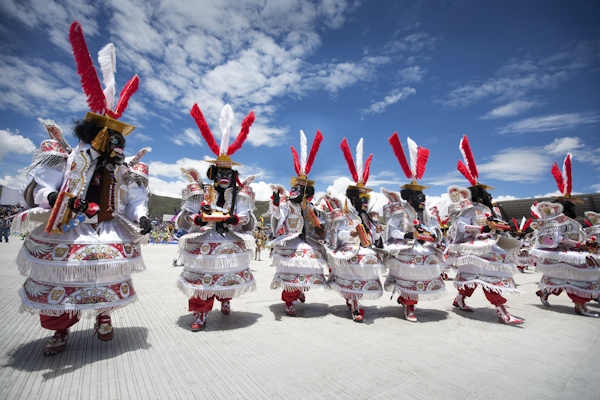An unmissable cultural encounter on the shores of Lake Titicaca in Peru

With over 100,000 dancers and 10,000 musicians, Peru’s largest celebration honors the Virgin of Candelaria as it parades through the streets of Puno at an altitude of over 3800 meters
Puno, the highland city dubbed “the capital of Peruvian folklore,” is the backdrop for the Festival of the Virgin of Candelaria, a fascinating cultural event that has been part of UNESCO’s Representative List of the Intangible Cultural Heritage of Humanity since 2014.
Every year in early February, Puno transforms, attracting visitors from around the world eager to witness indigenous and colonial traditions turned into a breathtaking display of choreographies and dances. Lasting for two weeks, this celebration is Peru’s largest festival, bringing together over 100,000 dancers and around 10,000 musicians, all dressed in traditional costumes and filled with boundless energy that captivates the crowd.
Declared a Cultural Heritage of the Nation in 2003, the Candelaria festival pays tribute to Mamita Candelaria, the patroness of Puno. Devotion to this figure originated in 1781 when the people of Puno, fearing the siege by Diego Cristóbal Túpac Amaru and troops led by Túpac Catari — an indigenous leader who led a significant rebellion against the Spanish Crown — processed the Virgin with lit candles and accompanied by groups of sikuris — traditional Aymara musicians playing the siku, a wind instrument — resulting in the invaders’ desertion.
The Patroness of Puno
Popularly known as Mamita Candelaria, the patroness of Puno carries the infant Jesus in her left arm, symbolizing light, and holds a lit candle in her right hand, along with a basket and two turtledoves. She wears attire crafted from fine fabrics like silk, adorned with golden threads and precious stones. To date, there are more than 100 unique mantles that are part of the Virgin’s collection.
Celebration Days
The population gathers outside the Church of San Juan Bautista in anticipation of the start of the traditional procession of the Virgin’s image, which traverses the main streets of the city amid an atmosphere full of religious fervor. Along the way, families hand out small papers with prayers or requests to their patroness.
During the Festival, two important dance competitions take place (native dances and dances with luminous costumes), broadcasted nationwide. The celebration continues with the traditional parade, featuring over 130 groups of native dances and more than 80 groups of mixed dances or luminous costumes.
Amidst the excitement of the dances, the richness of the costumes, and the religious fervor, this festival in honor of the Virgin of Candelaria continues to illuminate the hearts of those who witness this extraordinary cultural expression.
About Promperú
The goal of the Commission for the Promotion of Peru for Exports and Tourism (PROMPERÚ) is to position Peru globally by promoting its image, tourist destinations, and value-added export products, contributing to the sustainable and decentralized development of the country.